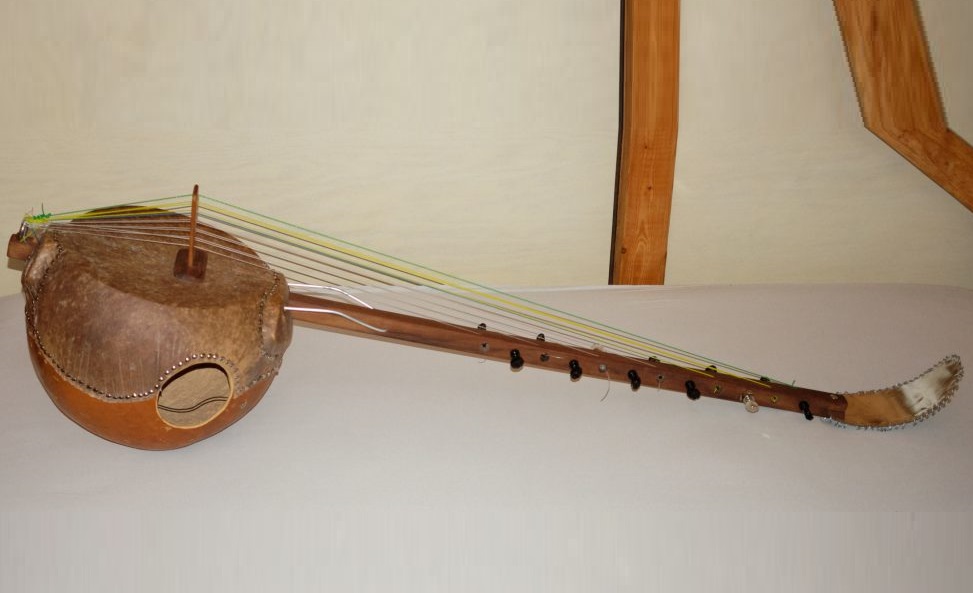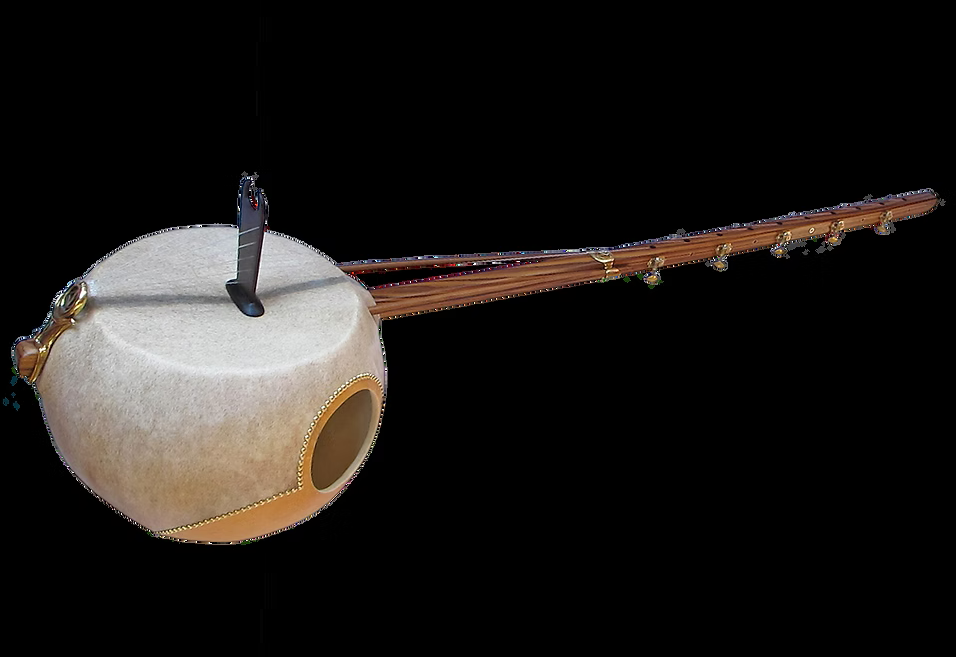Ngoni
Plucked Instruments
Africa
Between 1001 and 1900 AD
Video
The Ngoni is a traditional stringed instrument originating from West Africa. It is known for its deep historical and cultural significance, particularly among the Manding people of Mali, Guinea, Senegal, and Burkina Faso. This instrument is a type of lute, commonly made with a hollowed-out wooden body, a stretched animal skin soundboard, and gut or nylon strings.
The Ngoni produces a distinct, rhythmic, and resonant sound that has been integral to West African music for centuries. The Ngoni is classified as a plucked string instrument, belonging to the lute family. It is similar to other African stringed instruments, such as the Kora and Xalam, but is distinguished by its simpler construction and unique tuning. The instrument is played by plucking or strumming the strings, and it can be used to produce both melodic and percussive tones.
Historical Background
The Ngoni has a rich history that dates back to at least the 12th century. It is believed to have originated in the Sahel region of West Africa, particularly in Mali, where it was an essential part of the griot (oral historian and musician) tradition. The instrument was historically used to accompany storytelling, praise songs, and ceremonial music. As the griots traveled, the Ngoni spread throughout various West African countries, influencing the development of other stringed instruments.
During the transatlantic slave trade, elements of the Ngoni were carried to the Americas by enslaved Africans. Some scholars suggest that the Ngoni may have contributed to the evolution of the banjo in the United States. The instrument remains a vital part of West African musical traditions and has gained recognition in global music circles in recent decades.
Construction and Design
The Ngoni is traditionally handcrafted from natural materials. The body is typically carved from a single piece of wood, often from calabash or hollowed-out tree trunks. The resonator is covered with animal skin, usually from a goat or cow, which is stretched tightly to create a drum-like surface. This design enhances the instrument’s percussive quality while maintaining a warm tonal resonance. The neck of the Ngoni is a long wooden stick that extends through the body, allowing for adjustable tuning by sliding the strings up or down. The strings were originally made from animal gut but are now commonly replaced with fishing line or nylon for durability. The number of strings varies, ranging from four to eight, depending on regional traditions and player preferences.
Types of Ngoni
There are several variations of the Ngoni, each associated with different cultures and musical styles. The three most prominent types include:
Donso Ngoni: Also known as the hunter’s Ngoni, this type is associated with the Donso (hunter) societies of Mali, Burkina Faso, and Ivory Coast. It typically has six strings and is used in ritual and spiritual ceremonies, often accompanying songs that pay homage to ancestors and spirits.
Kamale Ngoni: The youth’s Ngoni, or Kamale Ngoni, is a more modern adaptation of the Donso Ngoni, featuring six to eight strings. It is played in a more melodic and rhythmic style, making it popular in contemporary African music.
Djeli Ngoni: Used by griots, or traditional storytellers, the Djeli Ngoni is typically smaller and has four to six strings. It is played in praise songs and oral histories that recount the exploits of kings, warriors, and historical figures.
Characteristics
The Ngoni is characterized by its lightweight design, portability, and rich tonality. It has a dry, percussive sound with a sharp attack, making it ideal for fast-paced, rhythmic playing. The instrument’s tuning can be altered by adjusting the tension of the strings, allowing for a range of tonal variations. Another defining feature is the playing technique. Unlike Western lutes or guitars, the Ngoni is often played with the thumb and forefinger, producing complex, polyrhythmic patterns. The instrument’s resonant body amplifies the sound naturally, making it suitable for solo performances as well as ensemble settings.
Playing Techniques
Ngoni players use a variety of plucking techniques to create intricate melodic and rhythmic patterns. The instrument is held against the player’s body, and the strings are plucked using both hands. Traditional griots employ syncopated rhythms, while modern players incorporate elements of jazz, blues, and other genres. The use of open tunings allows for drone notes that enhance the instrument’s harmonic richness.
Advanced techniques include muting the strings to create a percussive effect, bending notes for expressive phrasing, and combining plucked notes with tapping on the resonator. These techniques contribute to the Ngoni’s unique sound, which is both melodic and percussive.
Applications
The Ngoni is used in various musical settings, from traditional ceremonies to contemporary music collaborations. In West African cultures, it is played at weddings, naming ceremonies, and festivals. It is also a key instrument in Wassoulou music, a genre that blends traditional and modern sounds.
In recent years, musicians such as Bassekou Kouyaté have brought the Ngoni to international audiences, collaborating with artists from different musical backgrounds. The instrument’s adaptability has made it popular in world music, fusion, and even jazz settings.
Cultural Significance
The Ngoni holds deep cultural and spiritual significance in West Africa. Among the Manding people, it is associated with griots, who serve as historians, musicians, and social commentators. The Donso Ngoni, in particular, has spiritual connotations, as it is played in hunter’s rituals and ceremonies that honor nature and ancestral spirits. The instrument is also a symbol of resistance and identity, preserving traditional African musical heritage in the face of modernization and globalization. Its enduring presence in West African music highlights its importance as a vessel for storytelling, history, and cultural expression.
Maintenance
Proper maintenance of the Ngoni ensures its longevity and sound quality. The animal skin soundboard should be kept dry to prevent warping or tearing. If the skin becomes loose due to humidity, it can be tightened by gently warming it over a heat source. The wooden body should be protected from excessive moisture and direct sunlight to prevent cracking. Strings should be replaced periodically to maintain optimal tension and tonal clarity. Traditional gut strings require more frequent replacement than modern nylon or fishing line alternatives. The tuning pegs should be checked regularly to ensure they remain secure.
Most Influential Players
Several musicians have played a crucial role in popularizing the ngoni both within Africa and globally:
Bassekou Kouyaté – A Malian virtuoso known for his innovative approach to the ngoni, blending traditional and modern styles.
Cheick Hamala Diabate – A renowned griot and ngoni master who has introduced the instrument to international audiences.
Mamadou Sidiki Diabate – A member of the famous Diabate griot family, contributing to the global recognition of Malian music.
Aly Keïta – An artist who has explored the ngoni’s potential in jazz and contemporary music.
These musicians have expanded the instrument’s possibilities, inspiring new generations of players.
Maintenance and Care
Proper maintenance ensures the longevity and optimal performance of the ngoni. Key aspects of care include:
String maintenance: Regularly checking and replacing worn-out strings to maintain tuning stability.
Skin care: Keeping the animal skin clean and hydrated to prevent cracking or drying out.
Humidity control: Storing the instrument in a stable environment to avoid damage caused by excessive moisture or dryness.
Bridge adjustment: Ensuring the bridge is properly positioned to optimize sound production.
By taking proper care of the ngoni, musicians can preserve its tonal quality and durability for years.
Advantages and Disadvantages
The Ngoni offers numerous advantages as a musical instrument. Its lightweight and compact design make it easy to transport, and its rich, percussive sound is versatile enough for various musical genres. The instrument is also relatively simple to learn, especially for those familiar with stringed instruments.
However, the Ngoni does have some challenges. The animal skin soundboard is sensitive to changes in humidity, requiring careful maintenance. Traditional tuning methods, which involve sliding the strings along the neck, can be less precise than modern tuning mechanisms. Additionally, access to high-quality Ngonis outside of West Africa can be limited, making it difficult for international musicians to obtain authentic instruments.
FAQ
What materials are used to make the Ngoni?
The Ngoni is traditionally made from a calabash gourd covered with animal skin, usually goat or cowhide, for resonance. The neck is crafted from wood, and the strings were historically made from gut but are now often nylon or fishing line. Bridge and tuning pegs are also wooden, providing structural integrity.
What are the different types of Ngoni?
The Ngoni comes in various sizes and styles, including the Donso Ngoni (hunter’s harp) with fewer strings and the Kamale Ngoni (youth’s harp) with more strings for melodic versatility. Variants exist across West Africa, differing in tuning and size based on cultural traditions.
How is the Ngoni played?
The Ngoni is plucked with the fingers using a technique similar to the kora, often with rhythmic, percussive slaps. Players use both hands, with thumbs and index fingers plucking the strings, creating intricate melodic and harmonic patterns. It is commonly played in griot traditions and contemporary fusion music.
 Links
Links
References
Other Instrument
Categories



















